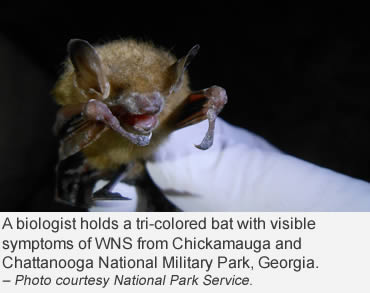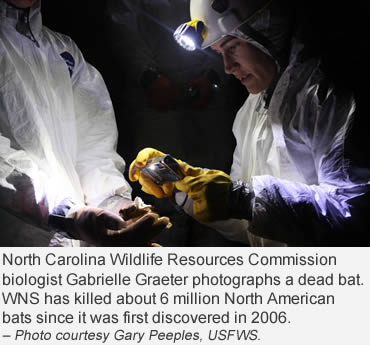Photo: WNS is evident in this Northern long-eared bat, photographed in January 2013 in LaSalle County, Illinois. – Photo courtesy Steve Taylor, University of Illinois.
The fungus behind white-nose syndrome, a disease that has ravaged bat populations in North America, may have an Achilles' heel: UV light.
This good news comes from a team of scientists from the U.S. Forest Service, U.S. Department of Agriculture, and the University of New Hampshire. In the course of their genomic analyses of P. destructans, the scientists found the fungus is highly sensitive to UV light.
Pseudogymnoascus destructans, known as P. destructans or Pd, is a cold-loving fungus that causes the infection known as white-nose syndrome. It thrives in the low temperature and high humidity conditions commonly found in caves and mines where bats hibernate.
 The disease was named for the white, fuzzy growths found on the nose, ears and wings of infected bats, and it has spread steadily, at alarming rates, for the past decade.
The disease was named for the white, fuzzy growths found on the nose, ears and wings of infected bats, and it has spread steadily, at alarming rates, for the past decade.
WNS was first discovered in a single cave in New York in 2006, and has now been found in more than 29 states and 5 Canadian provinces. More than 6 million bats died in the first 6 years of the WNS outbreak, and millions of bats remain in danger.
Bats play critical roles in controlling agricultural, forest and human pests. Recent studies estimate that the pesticide services of bats are worth more than $1 billion annually to the U.S. corn industry alone, and more than $3 billion annually to all agricultural production.
But there is new hope for bats and the critical role they play in the environment by eating insects, pollinating plants, spreading seeds.
P. destructans can only infect bats during hibernation because it has a strict temperature growth range of about 39 to 68 degrees Fahrenheit. However, treating bats for the disease during hibernation is challenging, so any weakness of the fungus may be good news to managers trying to develop treatment strategies.
The study was published January 2, 2018, in the journal “Nature Communications,” titled “Extreme sensitivity to ultra-violet light in the fungal pathogen causing white-nose syndrome of bats.” The research team suggests that P. destructans is likely a true fungal pathogen of bats that evolved alongside bat species in Europe and Asia for millions of years, allowing Eurasian bats to develop defenses against it.
In the course of comparing P. destructans to six closely related non-pathogenic fungi, researchers discovered P. destructans is unable to repair DNA damage caused by UV light, which could lead to novel treatments for the disease.
 “This research has tremendous implications for bats and people,” said Tony Ferguson, director of the Forest Service’s Northern Research Station and the Forest Products Laboratory. “Bats play a key role in the health of forests as well as the production of food in the United States, and developing an array of tools with which we can treat bats for white-nose syndrome is important to preserving these very important species.”
“This research has tremendous implications for bats and people,” said Tony Ferguson, director of the Forest Service’s Northern Research Station and the Forest Products Laboratory. “Bats play a key role in the health of forests as well as the production of food in the United States, and developing an array of tools with which we can treat bats for white-nose syndrome is important to preserving these very important species.”
The research team generated annotated genomes for P. destructans as well as six non-pathogenic Pseudogymnoascus species in an effort to gain insight into the origins and adaptations of the fungal pathogen of WNS.
Using comparative genomics, the research team noticed that P. destructans lacked a key DNA repair enzyme, prompting them to expose the fungi to DNA damaging agents, including different wavelengths and intensities of UV light.
They found that a low dose exposure of UV-C light resulted in about 15 percent survival of P. destructans while a moderate dose exposure resulted in less than 1 percent survival. These values translate to only a few seconds of exposure from a hand-held UV-C light source.
“It is unusual that P. destructans appears to be unable to repair damage caused by UV-light,” said Jon Palmer, a research botanist in the Northern Research Station’s lab in Madison, Wis., and the lead author of the study.
“Most organisms that have been found in the absence of light maintain the ability to repair DNA caused by UV light radiation. We are very hopeful that the fungus’ extreme vulnerability to UV light can be exploited to manage the disease and save bats,” Palmer said.
"White-nose syndrome is the single biggest threat to many North American bat species and one of the most pressing conservation challenges facing America’s wildlife today,” said Jeremy Coleman, national white-nose syndrome coordinator, U.S. Fish and Wildlife Service.
“Investing in defeating WNS must be a priority, and the results from this study and contributing research give us hope that we can develop the tools to more effectively manage the fungus that causes the disease.”
Research on potential treatment using UV light is underway.
Daniel Lindner, a research plant pathologist with the Northern Research Station in Madison and the corresponding author on the study, is leading follow-up research to determine if UV-light can be used as a treatment for bats suffering from white-nose syndrome. The study will measure the survival of little brown bats during hibernation after being treated with UV-light compared to control groups.
Co-authors of the study include Kevin P. Drees and Jeffery T. Foster of the University of New Hampshire.
The researchers are also exploring whether there are any non-target effects by measuring changes in the bat skin microbiome, both fungal and bacterial communities. The study, funded by a grant from the National Fish and Wildlife Foundation, Bats for the Future Fund, began in late 2017.
It available online at https://www.nrs.fs.fed.us/pubs/55557
– Resources: Northern Research Station News, U.S. Forest Service, U.S. Department of Agriculture, U.S. Fish and Wildlife Service, and the National Fish and Wildlife Foundation. For more information on White-Nose Syndrome, visit www.WhiteNoseSyndrome.org.